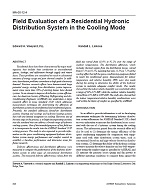Description
Residential ducts have been characterized by major inad-equacies that include heat conduction to unconditioned spaces, leakage, and infiltration through supply and return ducts. These problems are considered to result in substantial amounts of energy usage and poor thermal comfort. In addi-tion, distribution problems contribute to high peak electricity demand. Previous research efforts have demonstrated large potential energy savings from distribution system improvements since more than 50% of existing homes have ducted systems. In an attempt to improve distribution system efficien-cies, the American Society of Heating, Refrigerating and Air-Conditioning Engineers (ASHRAE) has undertaken a large research effort to issue Standard 152P, which addresses measurement techniques for determining the efficiency of distribution systems in unconditioned and conditioned spaces. Presently, the standard addresses forced-air distribution systems (heating and cooling) and hydronic heating systems but (with one limited exception) no cooling. However, one of the next steps in the process is to begin incorporating sections into the standard that can address a broad range of hydronic cooling systems. One of the intended purposes of this field test is to incorporate the results into the ASHRAE Standard 152P writing process. The study is also expected to provide information on the space conditioning equipment/hydronic distribution system energy performance and comfort control to establish a baseline performance and determine areas for future research. Delivery effectiveness and distribution efficiency were measured to compare the performance of the hydronic distribution system to other types of conventional distribution systems. The measured delivery effectiveness values from the field test varied from 81.4% to 92.2% over the range of outdoor temperatures. The distribution efficiency, which includes thermal regain from the distribution losses, varied from 87.5% to 92.5%, meaning that only 12.5% to 7.5% of the cooling effect that left the space conditioning equipment failed to reach the conditioned space. Measurements for indoor temperature and relative humidity (RH) were also made during the testing to determine the ability of the hydronic system to maintain adequate comfort levels. The results showed that the indoor relative humidity was controlled within a range of 46%-52% RH, while the outdoor relative humidity varied from 25% RH to 100% RH. The study also showed that the indoor temperature/relative humidity combinations were well within the limits of comfort as specified by ASHRAE.
Units: Dual
Citation: Symposium, ASHRAE Transactions, vol. 106, pt. 2
Product Details
- Published:
- 2000
- Number of Pages:
- 9
- File Size:
- 1 file , 180 KB
- Product Code(s):
- D-7280




